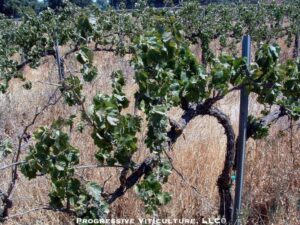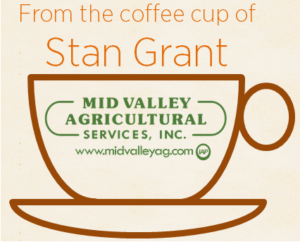 Vineyards are populations of grapevines and associated organisms supported by air, water, and soil resources. As such, they constitute ecosystems or perhaps more precisely, agro-ecosystems. While vineyard ecosystems are artificial, rather than natural, they are still subject to the laws of nature. Most of these laws are so fundamental that vineyard managers and viticulturists seldom have reason to consider them.
Vineyards are populations of grapevines and associated organisms supported by air, water, and soil resources. As such, they constitute ecosystems or perhaps more precisely, agro-ecosystems. While vineyard ecosystems are artificial, rather than natural, they are still subject to the laws of nature. Most of these laws are so fundamental that vineyard managers and viticulturists seldom have reason to consider them.
Here we will review four natural laws relevant to wine grape growing. This review is intended to benefit of those outside of the wine grape industry who wish to better understand the essentials of viticulture, as well as for those of us involved in grape growing. We begin with thermodynamics, which is the science of energy and matter transformation.
The First Law of Thermodynamics: Energy and matter can neither be created nor destroyed, but only transformed. Examples include the transformation of solar energy, carbon dioxide, and water into chemical energy and sugars during photosynthesis in grapevine leaves. This law can be stated another way: you can’t get something for nothing.
For viticulture, the first law of thermodynamics applies to the resources grapevines require for growth and development. It expresses the reality that farming with few or no applied inputs is nonviable (Figure 1). On the contrary, truly sustainable wine grape production requires inputs to replace resources, including water and mineral nutrients removed from the vineyard with the harvested crop. Failure to do so results in diminished returns and environmental degradation.
The Second Laws of Thermodynamics: Some useful energy is lost (mostly as heat to the environment) during energy transformations. Therefore, 100% efficiency is not possible. Also, as a system looses energy, that system and its surroundings tend towards increasing disorder.
Accordingly, successful grape growing not only requires inputs, but it also requires they be applied at the proper time and with the appropriate intensity to achieve the greatest possible efficiency and return on investment (Figure 2). The two laws that follow address some specific aspects of resource application.
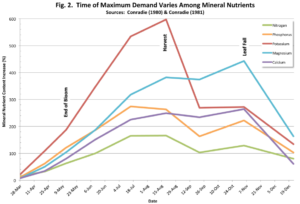
Fig. 2
The Law of the Minimum: Crop yield and quality are directly related to the most limiting resource and, after the amount of that resource is increased sufficiently, yield and quality will be determined by the next most limiting resource (Figure 3). For example, grapevines may be suffering from nitrogen deficiency, but nitrogen fertilization may only slightly increase grape yield and quality because the soil is also low in potassium. It follows that optimum wine grape production and quality depends on an adequate and balanced supply of all resources.
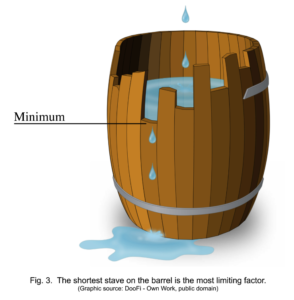
Fig. 3
The Law of Diminishing Returns: The first applied quantity of the most limiting resource will produce a large plant response, but with continued applications the magnitude of plant response will eventually diminish and, after some point, cease (Figure 4). This law may also be stated: if some is good, more is not necessarily better.
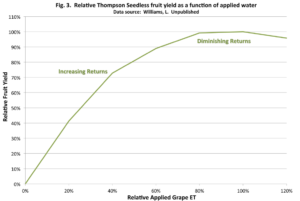
Fig. 4
For example, when grapevines are deficient in zinc they noticeably respond to an application of a fraction of a pound of zinc per acre, but they will not respond further as zinc applications exceed a few pounds per acre. For all resources, the greatest return occurs when plant response increases correspond to increases in resource cost. Beyond this point, there are diminishing returns on the resource investment, decreasing efficiency, and the increasing potential for environmental degradation.
Conclusions: We cannot defy nature. Rather we must work within the boundaries set by it as determined by science and described in natural laws, such as those above. Within them we have many opportunities and options to influence the performance of our grapevines and the character of our vineyard ecosystems for the benefit our businesses and society.
A version of this article was originally published in the Mid Valley Agricultural Services November, 2006 newsletter. It was updated for this blog post.
Further Reading
Follet, RH, Murphy, LS, Donahue, RL. Fertilizers and soil amendments. Prentice-Hall, Englewood Cliffs, New Jersey. 1981.
Salisbury, FB, Ross, CW. Plant physiology. Wadworth Publishing Company, Belmont, California. 1978.
Tisdale, SL, Nelson, WL, Beaton, JD. Soil fertility and fertilizers. Macmillan Publishing Company, New York. 1985.
Have something interesting to say? Consider writing a guest blog article!
To subscribe to the Coffee Shop Blog, send an email to stephanie@lodiwine.com with the subject “blog subscribe.”
To join the Lodi Growers email list, send an email to stephanie@lodiwine.com with the subject “grower email subscribe” or click on “join our email list” to the right.
To receive Lodi Grower news and event promotions by mail, send your contact information to stephanie@lodiwine.com or call 209.367.4727.
For more information on the wines of Lodi, visit the Lodi Winegrape Commission’s consumer website, lodiwine.com.

